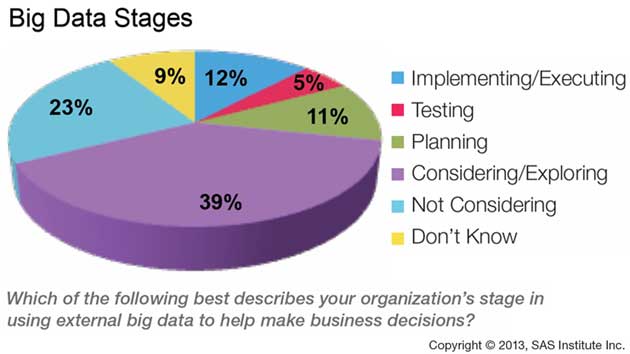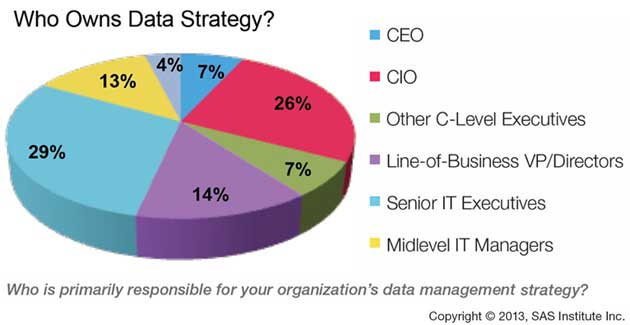Despite the hype, most organizations have yet to develop and implement a Big Data strategy, and few are taking advantage of product, customer, and other data sources, according to a survey of data management professionals by SAS and SourceMedia.
Just 12% of organizations surveyed are executing against a big data strategy in daily operations.
Moreover, only 5% are in the testing stage, and 11% are in the planning stage:

The most common reasons cited by respondents for not fully exploiting big data:
- 21% don't know enough about it.
- 15% don't understand the benefits.
- 9% lack business support.
- 9% lack data quality in existing systems.
Below, additional findings from the 2013 Big Data Survey report from SAS.
Lack of Data Quality and Data Governance
Asked about the likelihood that their organizations would use external big data in 2014, just 14% of respondents said "very likely" and 19% said "not likely at all." Specific concerns included data quality and accuracy, accessing the right data, reconciling disparate data, lack of organizational view into data, timeliness, compliance, and security.
The survey found no real consensus on who owns the data management strategy, with responses ranging from midlevel IT personnel up to the CEO:

Such confusion likely causes additional challenges in data strategy development and execution, SAS said.
Data Management Wishlist
Most respondents call detailed data analysis a priority for supporting business decisions, along with increased internal reporting and information access. Asked what they want from data solutions...
- 73% said data visualizations and dashboards.
- 53% said data profiling.
- 44% said software as a service (SaaS).

Data Types Collected
Customer and product data top the data types being collected by organizations.
The top customer data types are...
- Business consumer (B2B): 66%
- End-customer (B2C): 59%
- Citizen (public sector): 29%
- Patient (medical sector): 23%
The product data being collected for decision making include...
- Sell-side: 62% (data in catalogs or websites used to purchase end products)
- Buy-side: 61% (data on inventory, raw materials, and other assets within the supply chain)
- MRO: 40% (data on maintenance, repair and operations)
"Big data or not, data management will help determine which companies thrive and which ones struggle in the years to come," said Todd Wright, Global Product Marketing Manager for SAS DataFlux Data Quality. "The 12% of organizations that are already planning around big data enjoy a significant competitive advantage," he added.
About the data: An online survey was fielded in December 2012 to information management professionals. The 339 respondents were screened for involvement with their organization's data management tools and processes.




